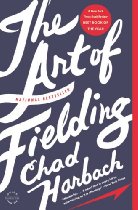 “The Art of Fielding”
“The Art of Fielding”
by Chad Harbach
Back Bay Books, 2012
Henry Skrimshander is a fairly unremarkable young man in most aspects– arriving at his first day of college he is undeniably scrawny, has brought with him only one book, and possesses neither the intelligence nor the charm necessary to earn the attention of his peers – except for one important exception: he is an incredible, virtuoso shortstop. And in Chad Harbach’s The Art of Fielding, baseball is king.
The author’s freshperson debut (to use his favored, if awkward, appellation) centers on the Harpooners of Westish College, a small school in the “crook of the baseball glove that is Wisconsin.” The team has been a beacon of mediocrity for many years, but Skrimshander’s arrival ushers in a new era of success. About to break the NCAA record for most consecutive errorless games, however, Henry makes an errant throw that clocks his roommate on the cheekbone, sending Owen to the hospital and Henry on a downward spiral of self-doubt and ever shakier plays.
The book, released today in paperback format, was published in hardcover in September – a hospitable time for the subject matter, coinciding as it did with the cinematic release of Moneyball, the Oscar-nominated film about underdog baseball team Oakland Athletics’ unlikely successes, and arriving hot on the heels of the final season of NBC’s critically acclaimed series Friday Night Lights, a sentimental tale of the trials and triumphs of a small-town football team.
While Harbach’s depiction of the cult-like world of athletics is without a doubt an eminently readable one, the near total lack of strong female characters is a nagging annoyance throughout. This makes sense to some extent, given the choice of milieu, but as Harbach is undoubtedly aware, the canon is hardly lacking in tomes devoted to male bonding. With The Art of Fielding, he is writing himself into a frustrating tradition of female invisibility, briefly acknowledged by Pella, the daughter of the school’s president, who condemns the one-dimensional portrayal of women in stories, “as if they lived and died so that men could have metaphysical insights.”
Despite this unfortunate shortcoming, the novel is a cozy read for an English major, as well as, I would imagine, a die-hard baseball fan. Harbach gives his reader plenty of meaty literary allusions to chew on, from the overt (Herman Melville’s statue holds court in the Westish courtyard and echoes of Moby Dick are never more than a few pages away) to the implicit (the title, ostensibly inspired by fictional shortstop Aparicio Rodriguez’s seminal baseball guidebook, also summons to mind eighteenth century satirist Henry Fielding). Lines like “literature could turn you into an asshole; he’d learned that teaching graduate school seminars” offer a knowing wink to the like-minded audience the author surely cultivated as co-founder and editor of the literary magazine n+1.
In a piece for what is now a rather less cerebral magazine, Hemingway claimed that he would forgo a guaranteed income of a million dollars a year in favor of the chance to read again for the first time some of his favorite novels (quite a hefty sum in 1935, when Esquire published the essay). As a recession-era college grad, and one less prone to hyperbole than the late, great bullfighter, I am disinclined to make so strong a statement, however as I turned the final page of The Art of Fielding, I did find myself longing to pick it up again and experience afresh the satisfaction of a compassionate, exuberant, and engaging read.
Hilary George-Parkin is a writer and editor living in New York City.
